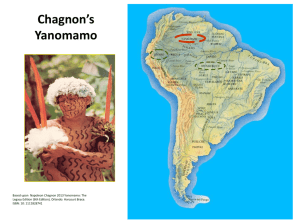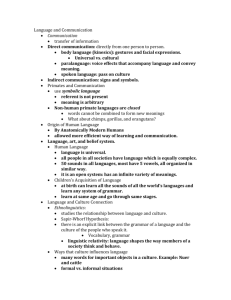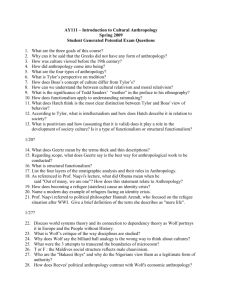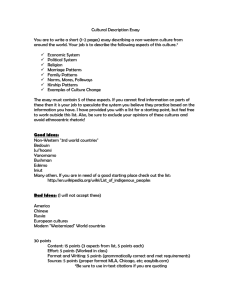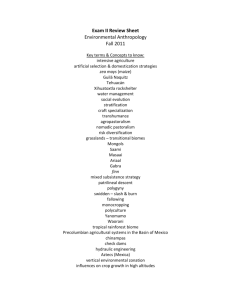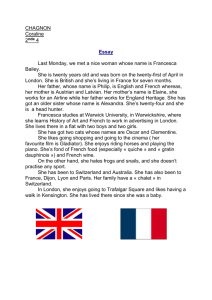The Case of the Yanomamo
advertisement
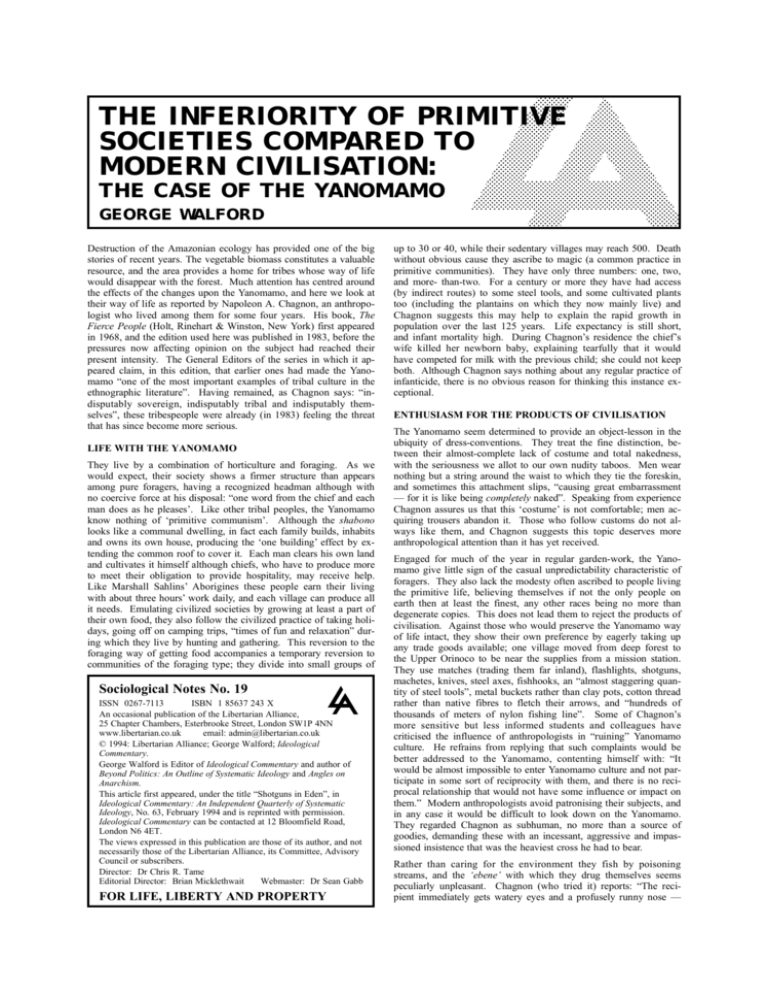
THE INFERIORITY OF PRIMITIVE SOCIETIES COMPARED TO MODERN CIVILISATION: THE CASE OF THE YANOMAMO GEORGE WALFORD Destruction of the Amazonian ecology has provided one of the big stories of recent years. The vegetable biomass constitutes a valuable resource, and the area provides a home for tribes whose way of life would disappear with the forest. Much attention has centred around the effects of the changes upon the Yanomamo, and here we look at their way of life as reported by Napoleon A. Chagnon, an anthropologist who lived among them for some four years. His book, The Fierce People (Holt, Rinehart & Winston, New York) first appeared in 1968, and the edition used here was published in 1983, before the pressures now affecting opinion on the subject had reached their present intensity. The General Editors of the series in which it appeared claim, in this edition, that earlier ones had made the Yanomamo “one of the most important examples of tribal culture in the ethnographic literature”. Having remained, as Chagnon says: “indisputably sovereign, indisputably tribal and indisputably themselves”, these tribespeople were already (in 1983) feeling the threat that has since become more serious. LIFE WITH THE YANOMAMO They live by a combination of horticulture and foraging. As we would expect, their society shows a firmer structure than appears among pure foragers, having a recognized headman although with no coercive force at his disposal: “one word from the chief and each man does as he pleases’. Like other tribal peoples, the Yanomamo know nothing of ‘primitive communism’. Although the shabono looks like a communal dwelling, in fact each family builds, inhabits and owns its own house, producing the ‘one building’ effect by extending the common roof to cover it. Each man clears his own land and cultivates it himself although chiefs, who have to produce more to meet their obligation to provide hospitality, may receive help. Like Marshall Sahlins’ Aborigines these people earn their living with about three hours’ work daily, and each village can produce all it needs. Emulating civilized societies by growing at least a part of their own food, they also follow the civilized practice of taking holidays, going off on camping trips, “times of fun and relaxation” during which they live by hunting and gathering. This reversion to the foraging way of getting food accompanies a temporary reversion to communities of the foraging type; they divide into small groups of Sociological Notes No. 19 ISSN 0267-7113 ISBN 1 85637 243 X An occasional publication of the Libertarian Alliance, 25 Chapter Chambers, Esterbrooke Street, London SW1P 4NN www.libertarian.co.uk email: admin@libertarian.co.uk © 1994: Libertarian Alliance; George Walford; Ideological Commentary. George Walford is Editor of Ideological Commentary and author of Beyond Politics: An Outline of Systematic Ideology and Angles on Anarchism. This article first appeared, under the title “Shotguns in Eden”, in Ideological Commentary: An Independent Quarterly of Systematic Ideology, No. 63, February 1994 and is reprinted with permission. Ideological Commentary can be contacted at 12 Bloomfield Road, London N6 4ET. The views expressed in this publication are those of its author, and not necessarily those of the Libertarian Alliance, its Committee, Advisory Council or subscribers. Director: Dr Chris R. Tame Editorial Director: Brian Micklethwait Webmaster: Dr Sean Gabb FOR LIFE, LIBERTY AND PROPERTY up to 30 or 40, while their sedentary villages may reach 500. Death without obvious cause they ascribe to magic (a common practice in primitive communities). They have only three numbers: one, two, and more- than-two. For a century or more they have had access (by indirect routes) to some steel tools, and some cultivated plants too (including the plantains on which they now mainly live) and Chagnon suggests this may help to explain the rapid growth in population over the last 125 years. Life expectancy is still short, and infant mortality high. During Chagnon’s residence the chief’s wife killed her newborn baby, explaining tearfully that it would have competed for milk with the previous child; she could not keep both. Although Chagnon says nothing about any regular practice of infanticide, there is no obvious reason for thinking this instance exceptional. ENTHUSIASM FOR THE PRODUCTS OF CIVILISATION The Yanomamo seem determined to provide an object-lesson in the ubiquity of dress-conventions. They treat the fine distinction, between their almost-complete lack of costume and total nakedness, with the seriousness we allot to our own nudity taboos. Men wear nothing but a string around the waist to which they tie the foreskin, and sometimes this attachment slips, “causing great embarrassment — for it is like being completely naked”. Speaking from experience Chagnon assures us that this ‘costume’ is not comfortable; men acquiring trousers abandon it. Those who follow customs do not always like them, and Chagnon suggests this topic deserves more anthropological attention than it has yet received. Engaged for much of the year in regular garden-work, the Yanomamo give little sign of the casual unpredictability characteristic of foragers. They also lack the modesty often ascribed to people living the primitive life, believing themselves if not the only people on earth then at least the finest, any other races being no more than degenerate copies. This does not lead them to reject the products of civilisation. Against those who would preserve the Yanomamo way of life intact, they show their own preference by eagerly taking up any trade goods available; one village moved from deep forest to the Upper Orinoco to be near the supplies from a mission station. They use matches (trading them far inland), flashlights, shotguns, machetes, knives, steel axes, fishhooks, an “almost staggering quantity of steel tools”, metal buckets rather than clay pots, cotton thread rather than native fibres to fletch their arrows, and “hundreds of thousands of meters of nylon fishing line”. Some of Chagnon’s more sensitive but less informed students and colleagues have criticised the influence of anthropologists in “ruining” Yanomamo culture. He refrains from replying that such complaints would be better addressed to the Yanomamo, contenting himself with: “It would be almost impossible to enter Yanomamo culture and not participate in some sort of reciprocity with them, and there is no reciprocal relationship that would not have some influence or impact on them.” Modern anthropologists avoid patronising their subjects, and in any case it would be difficult to look down on the Yanomamo. They regarded Chagnon as subhuman, no more than a source of goodies, demanding these with an incessant, aggressive and impassioned insistence that was the heaviest cross he had to bear. Rather than caring for the environment they fish by poisoning streams, and the ‘ebene’ with which they drug themselves seems peculiarly unpleasant. Chagnon (who tried it) reports: “The recipient immediately gets watery eyes and a profusely runny nose — long strands of green mucus begin to drip from each nostril. Dry leaves are also very common, as is out-and-out vomiting.” VIOLENCE Numbering about 12,000, distributed among some 125 villages, the Yanomamo retained complete control of their own destiny until a few years before this book appeared, and what they did with their freedom begins to appear on the first page of the main text: the opening paragraph brings up their traditional patterns of warfare, and a subhead introduces the murder of a guest leading to the massacre of 12 or 15 men. That makes about one in every thousand of their total population killed on one day; size for size, it compares with the Somme. “The thing that impressed me most was the importance of aggression in their culture”, both individual vindictiveness and collective bellicosity. A regular series of degrees of violence has been institutionalized; it ranges from chest pounding through side slapping (both more likely to cause injury or death than the phrases suggest) through club and axe duels to all-out warfare, complete with treacherous massacres. About 30 per cent of adult male deaths are directly attributable to warfare or personal combat. Inter-village raiding is endemic, one village getting raided twentyfive times during Chagnon’s first 15 months of fieldwork and whatever may occur among other peoples, Yanomamo raiding cannot be written off as sport or ritual; raiders are out to kill warriors. They also capture women, any taken being raped by all the men in the raiding party and afterwards passed on to the others who stayed at home. Warfare appears as a main interest supported by a set of beliefs urging strong villages to take advantage of weaker ones, coercing them into handing over women. Inter-village warfare affects all aspects of their social organization and daily routines, and the need for alliances largely decides the location of settlements, although allies can be even less relied on for benevolence than among ourselves. On one occasion Chagnon found himself guarding the people left in a village while the warriors were away; no enemies threatened, but they were expecting a raid by their allies. SUBJUGATION OF WOMEN Headmen, lacking formal authority, rely upon charisma, support from kinsfolk and a reputation for ferocity. The Yanomamo term for this quality, waiteri, recurs throughout the book, and beating a wife with a club is one way of displaying it, a warning to other men. This does not mean that wives are otherwise safe; to avoid charges of exaggeration I quote this next passage verbatim: Most reprimands by irate husbands take the form of blows with the hand or a piece of firewood, but a good many husbands are even more severe. Some of them chop their wives with the sharp edge of a machete or an axe, or shoot them with a barbed arrow in some nonvital area, such as the buttocks or leg. Many men are given to punishing their wives by holding the hot end of a glowing stick against them, resulting in serious burns. One man punished an unfaithful wife by cutting both her ears off with a machete, and when the exigencies of warfare oblige a group to share the village of their allies for a while, they pay their rent in women. Women are used as political counters, given in marriage by their older kinsmen to form alliances; they inherit most of the duties of the kinship group without enjoying the privileges. One passage forces us to ask whether it might not be well for anthropological studies to emulate charity and begin at home. Chagnon declares, without reserve or qualification: Those of us who live in industrial society look on change and progress as being “good” and “desirable”. Our entire system of values and goals is constituted in such a way that we strive to make changes, improve and tinker with rules and technology, and reward those who are skilful at it. CURRENTLY APPROVED MYTHS Has he never met the phrase ‘good old times’? He should have a word with Mrs Thatcher about Victorian values, or with Mr Major about going back to basics or, for that matter, consult any exposition of conservatism for an account of the belief that the only changes to be supported are those that help to avert greater ones. Reporting his anger and frustration when contemplating the changes introduced by the mission stations (then the main agents of change) Chagnon adds that other anthropologists share these feelings. They often regret the changes affecting the peoples they study, especially those diminishing their freedom and dignity. The freedom in question for the Yanomamo is presumably that of the men surviving after one-third of the adult males have been killed off, not that of the mutilated wives or of the babies killed by mothers unable to feed them. And the dignity is — well, whose? Hardly that of the men vomiting under drugs, of the girls traded by their kinsmen, or of the women with barbed arrows (Yanomamo arrows are 6 feet long) through their legs or buttocks, burnt with red hot sticks or with their ears chopped off. A serious scholar like Chagnon faces problems in reconciling his observations with the currently approved myths. The Yanomamo themselves reach eagerly for what civilisation offers. Do they perhaps show a sounder appreciation of their interests than those who would condemn them to unending service as exemplars of an early way of life, one valued by people who do not have to suffer it? EXCEPTIONAL IN NOT YET HAVING HAD THEIR COMBATIVENESS RESTRAINED Although we speak here only of the Yanomamo, their behaviour inescapably carries implications for our general thinking about both primitive communities and violence. Chagnon’s subtitle distinguishes his subjects as “the fierce people”, and indeed the literature says little about any other tribes showing comparable enthusiasm for duelling, treachery, warfare and murder. This can mislead us if we overlook his explanation: “the emergence of a mature anthropological discipline came long after most tribesmen had been pacified.” The Yanomamo are exceptional mainly in not yet having had their combativeness brought under restraint. Although civilisation has by no means eliminated violence and warfare, it has limited, localised and to some extent (witness the Geneva Convention) controlled them, replacing a chronic condition by sporadic acute attacks. Unlike the Yanomamo, and other tribes in their pre-contact condition, most civilized people spend most of their lives enjoying a high level of security. Chagnon suggests that set against some of our own activities the Yanomamo look more like angels than devils. That remark might be justified if civilised nations were killing off a third of their adult males, and civilised husbands mutilating their wives as a matter of course; as things now stand, it constitutes a victory of conformism over scholarship. Our population rockets upwards; on Chagnon’s own showing only after this civilisation he considers so murderous had contacted the Yanomamo did theirs began to follow suit. The book concludes with the suggestion that the Yanomamo yet uncontacted may be able to teach foreigners something about becoming human. Perhaps so, but some knowledge we are happier without. OTHER TRIBAL PEOPLES RESPOND IN MUCH THE SAME WAY Chagnon notes that those who comply with conventions do not always like them, and this may well be true of the Yanomamo. The eagerness with which they have taken up the civilized products available to them suggests a readiness to depart from their conventions once an alternative becomes available. In this they are not alone. Other tribal peoples respond in much the same way, and the inhabitants of what are now the advanced parts of the world (few of whom show any desire to take up the tribal way of life) have done so throughout their history. Chagnon’s indications of submission to the current conventions show careful restraint and even ambiguity, as when he mentions not having found the same quality of life elsewhere. One can easily read a hidden message into them: “I’m making these vapid comments because they are expected of me, but if you take them seriously, after the evidence I have presented, the more fools you”.



